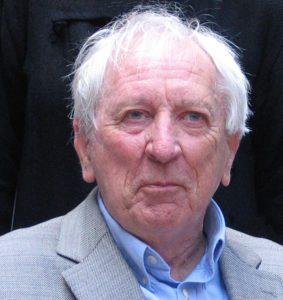
Between 2001, when The Half-Finished Heaven: Selected Poems was first published, and now, Tomas Tranströmer won the Nobel Prize and died. It seems reasonable, then, to rerelease the volume with additional prefatory matter and fourteen additional poems. According to its Graywolf page, those fourteen poems mean the expanded edition of The Half-Finished Heaven is now the only complete, definitive record of Robert Bly’s Tranströmer translations. As it was Bly who imported Tranströmer to America—and Tranströmer has become a giant here—this fact is of some note.
More momentous is the poetry itself. In a century that has seen literature flooded with every political and social message, and has tended increasingly toward spoken-ness, Tranströmer’s unspoken-ness, his attention to things per se, and his keen sense of an invisible world, serve as reminders of an older way of making poems. In Tranströmer’s work, almost everything that exists or needs attention isn’t mentioned. Instead, he counts on his reader’s imagination to fill in his poems’ vast empty spaces.
“Tomas Tranströmer has a strange genius for the image,” writes Bly in the introduction to the original edition. Bly continues: “His poems are a sort of railway station where trains that have come enormous distances stand briefly in the same building.” These “trains” are disparate and sometimes surrealistic images, often juxtapositions of manufactured and natural, or of realistic and magical, whose proximity in a single poem somehow makes sense. They’re things that, though different, seem to belong on the same plane, much the way a transportation metaphor seems to belong in a discussion of Tranströmer’s writing. One feels similarity even if at first one isn’t sure why.
In the introduction to this, the expanded edition, Bly describes Tranströmer’s use of language as “entangled in what some would call the mists of childish fancies, or the mysterious roots of language, with bits of sleep still clinging to it, or language that has not given in to corporate closing up of possibilities…” This is classic Bly, by the way. He just loves the dreamy, Jungian otherworld that quietly informs ours, and he adores poets fluent in that world’s tongue. “Leaping” poets he’s sometimes called them.
What I value most about Tranströmer is available throughout this fine collection. I like how he lets the depressingly realistic become something slightly magical. It happens slowly, almost imperceptibly. Beneath a poem about school, or driving, or a “political argument”—or any other depressingly pedestrian occasion—there is a buoyancy. It often comes from unexpected diction that unsettles the poem’s voice. Sometimes it comes from images that turn and shift the poem’s context.
In terms of structure, the book is divided into four sections that roughly correspond to the four decades of Tranströmer’s writing: the 1950s, 1960s, 1970s, and then the 1980s to the end (he suffered a stroke in 1990 but continued to write).
In the first section, the poems are shorter and Tranströmer’s approach more apparent. Imagery of nighttime and darkness dominates; cars, trucks, trains and other modern vehicles contrast against dreamlike flowers, trees, and leaves (“cherry trees in bloom pat the heavy trucks on the way home”); and the poet’s heart is bound up in music, music, music, sometimes verbal, but more often music made on the piano.
The best moments here are when real situations take on dreamlike hues. I particularly like, in “Dark Shape Swimming,” the lines, “a shadowy shape that swims / on some ancient fresh river,” followed in the next stanza by, “the swimmer is parted from his shadow / which is slipping along the bottom.” The swimmer’s goal is to get to the other shore and “join his shadow again.” This is a real and seeable situation, but the way Tranströmer frames it, it seems like a dream.
Tranströmer’s trick is to create cognitive turbulence with tiny, quick-hitter juxtapositions like “ancient fresh,” and then, when the reader is unsteady but doesn’t realize it, to roll out a more substantial banana peel like “join his shadow again.” It’s important to remember that very few, if any, swimmers think about rejoining their shadow. That the swimmer in the poem does is untrue, and is part of how Tranströmer moves the reader into a dreamlike state. It’s a form of hypnosis, I think.
Some poems in the first section are softer, such as the perfectly lovely “Allegro,” which begins:
After a black day, I play Haydn,
and feel a little warmth in my hands.The keys are ready. Kind hammers fall.
The sound is spirited, green, and full of silence.
How easily the poet moves from literal to symbolic: “warmth in my hands” and “kind hammers fall” are both perfectly literal and also perfectly literary. Is it possible to read these four lines and not want more?
Tranströmer might be providing his ars poetica in the concluding lines of “Nocturne”: “In the slot between waking and sleep / a large letter tries to get in without quite succeeding.” He also must be referencing his burgeoning correspondence with Robert Bly, both at this point in their early thirties.
The second section sees Tranströmer composing longer poems, some even in prose (he is a real poet). Its first poem, “Open and Closed Space,” begins in a familiar mode:
With his work, as with a glove, a man feels the universe.
At noon he rests a while, and lays the gloves aside on a shelf.
There they suddenly start growing, grow huge
and make the whole house dark from inside.
To an ordinary poet, work gloves may seem an inadequate metaphor for the universe, but to Tranströmer they’re ideal. For no reason at all, they fill his house with darkness. Come to think of it, neither work-gloves nor the universe do this. After introducing a handful of mid-sized brain-jumblers, the poet notices that shadows on fir-matted valleys “do not move.” The poem concludes, “No, they are moving.” Great line. Single meaning, double meaning, maybe triple, so I reread the poem and find what it means to be a Tranströmer poem. It is no more familiar and no less sweet-spirited in its composition. Stanza by stanza, it goes off at wild angles with which I’m comfortable.
Another new element in the second section is the presence of dialogue, often of inanimate objects talking to one another, or just to the air.
And there’s another ars poetica embedded in the conclusion of “Morning Bird Songs”:
Fantastic to feel how my poem is growing
while I myself am shrinking.
It’s getting bigger, it’s taking my place,
it’s pressing against me.
It has shoved me out of the nest.
The poem is finished.
Honestly, I can’t stop enjoying this book. As I write, I’m on my fourth or fifth time through, and these lines still make me laugh and feel at ease. Tranströmer’s poetry makes his readers his close friends. If one pays attention to his chiaroscuro, looks for moments of contrast between man-made and natural (“A hum in seashells and telephones”), and is able to allow the non sequiturs to just happen, one is rewarded with a very rich and memorable poetic experience. Tranströmer describes the tide in “Slow Music,” for example, as “stones” that “have been gradually walking backwards out of the sea.” This is surrealistic poetry at its humblest.
The third section, representing Tranströmer’s 1970s, expands into more extensive descriptions with place- and time-specific references, but this new realism doesn’t make it any less strangely wonderful, as in “The Scattered Congregation”:
We got ready and showed our home.
The visitor thought: you live well.
The slum must be inside of you.
Also in “Calling Home”:
A telephone call flowed out into the night, and it gleamed here and there in fields, and at the outskirts of cities.
And in “Below Freezing”:
We are at a party that doesn’t love us. Finally the party lets the mask fall and shows what it is: a shunting station for freight cars.
And in “Schubertiana,” in which he finally reaches New York City:
Outside New York, a high place where with one glance you take in the houses where eight million human beings live.
Finally, the fourth section of the book, especially “Grief Gondola #2,” which in the intro Bly calls a “masterpiece,” is equally mesmerizing. Perhaps there wasn’t a fallow period in Tranströmer’s career.
Looking back again at the new introduction, I notice Bly’s recollection of how he and Tranströmer first made contact. In 1962, in some journal or newspaper, Bly came across a review of a Tranströmer book, and it seemed very similar to what he himself was trying to write. Bly and James Wright were buddies at the time, and both of them were trying to create, he recalls, a “naked poetry… without political or philosophical baggage.” This is what the then-young Swede was also doing. So Bly drove from his rural Minnesota farm to Minneapolis, checked the book out of the library, wrote Tranströmer a letter. Thus began a lifelong friendship.
Tranströmer might be instructive to our young poets writing today. The poem, he seems to say, doesn’t have to carry every burden of its poet’s heart. It doesn’t need to speak out loud, either. It can, and maybe ought to, muse a bit more quietly to itself, and let its readers share in the creative process by their reading.
***
Author photograph © Andrei Romanenko.





